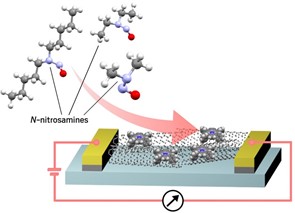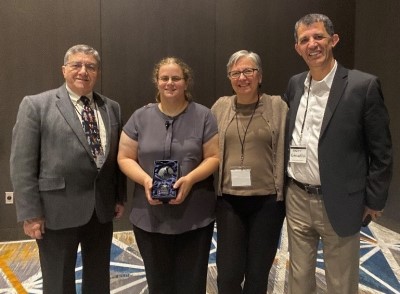Hot Off the Press
The Superfund Research Program (SRP) regularly highlights basic and applied research and activities from the program that span multiple disciplines.
Research Briefs

Nanotube Sensor Detects Nitrosamines in Air
Massachusetts Institute of Technology SRP Center researchers have developed a sensitive and inexpensive carbon nanotube-based sensor that can measure N-nitrosamines in air. Classified as probable human carcinogens, N-nitrosamines are formed as by-products during manufacturing and have been found widely in air, water, and food.
Modeling Approaches Estimate Exposure and Simulate Impacts on Health
Researchers from the Boston University SRP Center developed and applied novel statistical models to cost-effectively predict chemical exposures and their associated harm to human health in large populations. These statistically powerful approaches can help address the challenges of measuring exposures for large populations and quantifying the health benefits of exposure reduction.
Collaborative Cross Mice Can Fill Data Gaps in Risk Assessment
SRP grantees at the Texas A&M University SRP Center showed how the Collaborative Cross (CC) mouse model, which uses genetically diverse mice to capture over 90% of known mouse genetic variations, can account for individual population differences in susceptibility to environmental chemicals. Researchers measured variability in kidney toxicity and metabolism in CC mice after exposing them to tetrachloroethylene. For kidney toxicity mediated by this chemical, they found that default risk assessment factors used to account for human variability may be marginally adequate to protect 95%, but not more, of the population.
NIEHS Environmental Factor Articles

Superfund Wetterhahn Award Goes to Elana Elkin
On Nov. 19, during its Annual Meeting, the SRP announced that Elana Elkin, Ph.D., is the 22nd recipient of the annual Karen Wetterhahn Memorial Award. Elkin is a trainee in Northeastern University's Puerto Rico Testsite for Exploring Contamination Threats (PROTECT) SRP Center. As a postdoctoral researcher at the University of Michigan, which is part of PROTECT's multi-institution collaboration, Elkin examines how exposure to environmental contaminants may affect placental development and function, which play a role in preterm birth and other adverse birth outcomes.
Chemicals Alter Fat Cells, Disrupt Healthy Metabolism
Chemicals can work differently through the same biological receptor to generate different types of fat cells and disrupt healthy metabolic functions, according to Stephanie Kim, Ph.D., in an Oct. 21 lecture at NIEHS. Kim, winner of the 2018 Wetterhahn Award, described how two chemicals, tributyltin and triphenyl phosphate, affect the process that triggers pre-fat cells to develop into different types of fat cells, called adipocytes.
Grantees Share History and Research Through Video Series
A new video tour showcases the history, challenges, and resilience of the community surrounding the New Bedford, Massachusetts Superfund site and SRP research to improve the health and well-being of local residents. The six-part Virtual Tour of New Bedford Harbor, released by the Boston University SRP Center, features interviews with center researchers, community members, U.S. Environmental Protection Agency partners, and more.
SRP Risk e-Learning Webinar Series: Bioremediation - Expanding the Toolbox
The SRP hosted a Risk e-Learning webinar series this fall on new approaches for bioremediation. The series featured biologically based engineering tools to improve existing bioremediation approaches and improve human health. It attracted more than 1,000 live participants over three sessions.
The September 30 session, Bioremediation - Expanding the Toolbox: The Microbiome , served as an introduction to the series and touched on opportunities to build linkages with other microbiome fields of study, such as the human microbiome. The presenters were William A. Suk, Ph.D., NIEHS Superfund Research Program; James Tiedje, Ph.D., Michigan State University; and Raina Maier, Ph.D., and Paul Carini, Ph.D., University of Arizona.
The October 3 session, Bioremediation - Expanding the Toolbox: Novel Omics Approaches ,described genomic approaches to enhance bioremediation by microbes and plants. The presenters were Claudia Gunsch, Ph.D., Duke University and Julian Schroeder, Ph.D., University of California, San Diego.
The October 11 session, Bioremediation - Expanding the Toolbox: Emerging Opportunities ,highlighted new and emerging methods, such as nanotechnology tools and advances in machine learning, to improve existing bioremediation approaches and improve human health. The presenters were Pedro Alvarez, Ph.D., Rice University; Dora Taggart, Microbial Insights; and Ameen Razavi, Microvi Biotechnologies.
Be sure to check out our past Risk e-Learning webinars ,which highlight innovative SRP-funded biological, environmental, and engineering research and tools to understand and reduce exposures to hazardous substances.
to Top



